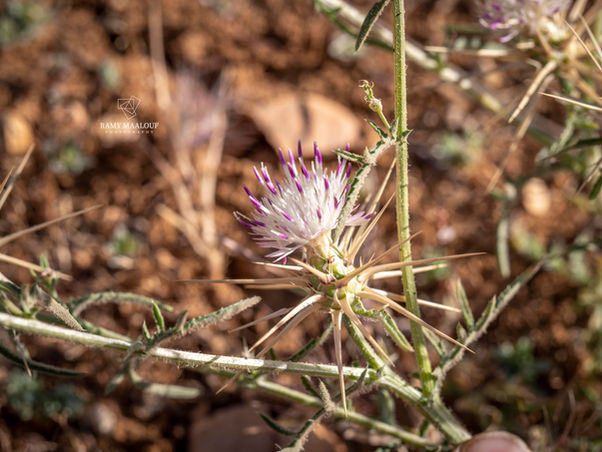Family |
Asteraceae
Centaurea iberica subsp. meryonis
Bornm.
Leb. Syr. Pal.
Centaurea iberica subsp. meryonis (DC.) Bornm.
(Beih. Bot. Centralbl. 31(2): 233; 1914 – basionym: Centaurea meryonis DC., Prodr. 6: 597; 1838 – Nouvelle Flore du Liban et de la Syrie, vol. 2, Pl. CCCII nº 1 et 2; 1969)
• Life-form & habit: Annual to biennial herb, 20–80 cm tall, erect, much-branched, divaricate, and greyish-green. Stems striate, angled, and sparsely covered with short, rough hairs.
• Leaves: Basal leaves lyrate-pinnatifid or pinnatisect, 5–15 × 2–4 cm, lobes obtuse or mucronulate-dentate; upper leaves smaller, sessile, entire or lobed, linear-lanceolate, semi-amplexicaul. Both surfaces greenish-grey, slightly papillosely pubescent.
• Inflorescence & flowers: Capitula solitary, ovoid to globose, 1–1.5 cm in diameter, borne on short peduncles. Involucre pale green, coriaceous, glabrous, with narrow, scarious margins; appendages short, ovate to triangular, with 1–3 pairs of short lateral spines and a terminal stout spine up to 5 mm. Florets purple to lilac; marginal florets radiant, sterile; inner florets tubular, fertile.
• Fruit: Achenes oblong, 3–4 mm long, brownish, faintly striate; pappus short, of unequal, scabrid bristles.
• Phenology: Flowers from May to July; fruits mature from June to August.
• Habitat & elevation: Dry hillsides, rocky pastures, and open steppe habitats on calcareous or marly soils, from 500 to 1 700 m; thrives in disturbed, sunny locations.
• Lebanese distribution: Reported by Mouterde (as Centaurea iberica var. meryonis) from the Beqaa Valley and Mount Lebanon foothills — particularly Zahlé, Dahr el-Baïdar, Barouk, and Ras Baalbeck; frequent on rocky slopes and field margins.
• Native range: Lebanon-Syria, Palestine (POWO).
• ⚠️ Taxonomic note: A Levantine subspecies within the polymorphic Centaurea iberica complex. Distinguished by its shorter involucral spines, smaller capitula, and greyish-green, sparsely hairy leaves. The form described by Mouterde as var. meryonis corresponds to populations with reduced spination and compact habit, characteristic of submontane limestone steppe vegetation in the central Levant.



